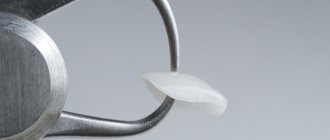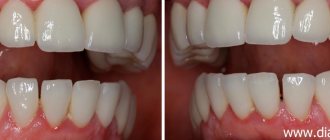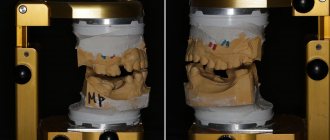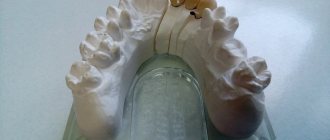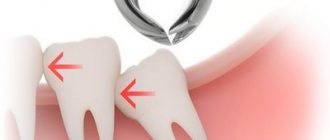Distal bite (prognathia) in children and adults
This type of anomaly is the most common malocclusion in the practice of any orthodontist.
Distal occlusion is a relationship of the jaws when the lower dentition is in a posterior position relative to the upper one: due to underdevelopment of the lower jaw and/or due to excessive development of the upper jaw.
A child is born with physiological progeny, which helps him pass through the birth canal with minimal trauma. Sucking the mother's breast (or orthodontic pacifier) stimulates the growth of the lower jaw - and by the time teeth erupt, the lower jaw “catches up” with the upper jaw.
What is a gap from a dental point of view?
In dentists' language, the gap between teeth is called diastema (from Greek - “gap, distance”). According to statistics, varying degrees of this defect are present in every fifth adult on the planet. In childhood, increased interdental space is often temporary; it is observed in 50% of preschool children. Diastema refers to an abnormally large empty space between the incisors (can reach 10 mm).
Patients often confuse a diastema (a gap between “units”) with a trema (a gap between any teeth in a row), although formally these are completely different defects, although similar in essence. Accordingly, the approach to treatment/elimination is different in both cases.
Preparation for dental prosthetics – root canal treatment with a microscope, tooth extraction, implantation
The patient, according to the treatment plan, underwent re-treatment of the dental canals with a microscope, the dental canals were tightly sealed, three teeth in the lower jaw were reinforced with fiberglass pins, since the upper part of the teeth was badly damaged.
A wisdom tooth on the lower right has been removed. At the bottom left is an Astra Tech dental implant. Astra Tech implants have been installed by Dial-Dent specialists for more than 10 years. This dental implant system, which uses the latest materials and technologies, has earned the trust of our specialists. The manufacturer pays great attention to the quality and safety of dental implants and all their components.
Reasons for the appearance and enlargement of gaps between teeth
The gap between the front teeth is a result of internal or external factors. Most often it occurs as a result of:
The cause may also be the presence of microdentia, which inherently affects the symmetry of the teeth.
An increase in an existing gap occurs for the following reasons:
- abuse of chewing seeds;
- progressive problems with the root system;
- the appearance/development of various types of orthodontic pathologies;
- Frequent chewing of hard food (particularly with the front teeth).
Correct and recommended prevention will help maintain the diastema at the existing level (prevent the distance between the incisors from becoming larger), and the orthodontist will select an individual program for eliminating the defect.
Types of diastemas
How the gap between the teeth can be removed depends on the reasons why the gap appeared. Therefore, it is very important to correctly identify the species. Diastemas are classified according to three main characteristics:
- By time of occurrence of the defect
:- False
. It is diagnosed in children when the bite is not yet fully formed. The problem disappears on its own without third-party intervention after replacing baby teeth with permanent ones. - True. Diagnosed in adolescents and adults in the period after the formation of the bite. It occurs due to periodontal pathologies, injuries or the absence of some frontal teeth in a row.
- By location
:- Symmetrical
. The location is determined relative to the conditional center of the dentition (usually oriented along the frenulum). The position of the incisors relative to each other is also taken into account. - Asymmetrical
. Most often, one of the incisors is in its place, and the second is deviated relative to the conditional center. - According to the position of roots and teeth
:- Literal deviation of crowns
. The defect is most often observed in people with a superset of teeth. In this case, the position of the roots is correct, but the incisors themselves deviate. Usually the gap in this case is no more than two millimeters. - Hull literal offset
. A common cause of the defect is excessively compacted bone tissue of the middle suture, which does not allow teeth to erupt in the place where they are needed. It is expressed in the lateral displacement of both the root and the incisor. - Medial tilt
. The most complex defect that can occur with the central incisors. As in the previous case, teeth and roots shift, but they can grow not only to the sides, but also with a displacement around their own axis.
To understand how to remove the gap between the front teeth and which method is best to choose, the dentist must correctly determine the type of diastema. Keep in mind that it is impossible to get rid of a gap on your own or at home - you cannot do this without the help of a specialized doctor.
Dial-Dent specialists who created this beautiful smile:
- Orthopedic dentist – treatment planning, development of dental restoration models, ceramic dental prosthetics.
- Dentist-endodontist – re-treatment of tooth canals with a microscope, strengthening teeth with fiberglass pins.
- Implant surgeon V.P. Alaverdov – removal of wisdom teeth, installation of a dental implant.
- Dental assistants M. Smirnova, A. Antoshkina, M. Erkimbekova.
See other examples of the work of Dial-Dent specialists here.
Make an appointment for a consultation by phone +7-499-110-18-04 or through the form on the website. You can ask questions about dental prosthetics to the chief doctor of the clinic, Sergei Vladimirovich Tsukor, at
How can a gap be dangerous?
A small gap between the teeth can be a highlight and be regarded solely as an aesthetic defect. This problem does not bother some people, even those who are often under the gun of video cameras (for example, E. Temnikova, Madonna, K. Novikova, V. Paradis, K. Raikin, etc.). However, in some cases, diastema can cause serious functional disorders. Without therapeutic intervention, the size of the gap will increase, which has the following consequences:
- speech defects (their degree depends on the size of the diastema);
- violation/change in bite (due to uneven chewing load on the upper and lower jaw);
- caries (pathogenic bacteria and hard deposits accumulate in the interdental space; regular home cleaning is not always enough to combat them);
- inflammation and other gum diseases (due to direct contact of the gums with chewed food).
An experienced orthodontist can determine exactly how to remove the gap between the front teeth and whether it is necessary for medical reasons. If the defect is purely aesthetic, then only you can decide whether it needs to be eliminated.
How to remove a gap between teeth
The main task that a dentist faces when solving the problem of diastema is to achieve the most even alignment of the central incisors. Depending on the chosen method, this process may take 2-3 dental procedures or last several years (the duration of treatment depends on the complexity and causes of the problem, the age of the patient and other factors).
Modern dentistry offers as many as 10 progressive methods of combating the gap between the front teeth:
- Surgical plastic surgery.
- Bracket systems.
- Records.
- Veneers.
- Lumineers.
- Cosmetic correction.
- Artistic restoration.
- Crowns.
- Implants.
- Mouthguards.
It would not be superfluous to study in detail the features of each technique, comparing their effectiveness and other characteristics.
Surgical plastic surgery
This method is used in the case of a congenital defect associated with an incorrect position of the labial frenulum (it is because of this that the incisors cannot close correctly). Surgical plastic surgery of the frenulum will not remove the gap, but will create conditions under which the teeth will be able to take the correct position. And after this, the dentist selects an effective method of correction. This technique has several nuances related to the patient’s age:
- This procedure is most effective for children 5-8 years old - after the operation, the incisors will close on their own without additional dental intervention.
- After surgery, older patients will be forced to wear orthopedic structures (some of which are fixed not temporarily, but permanently).
The plastic surgery itself is safe for health and painless. Does not require long time for rehabilitation and recovery.
Bracket systems
They are non-removable orthodontic structures designed to straighten the dentition. Parts of the structure are fixed directly on the teeth (from the outside or inside). The use of braces to eliminate gaps between teeth has its own nuances:
- The method is most effective for patients under 16 years of age, when the jaw tissue is not yet fully formed. For older patients, wearing braces may not help (depending on the individual characteristics of the problem).
- The duration of treatment can be up to three years. Braces cannot be removed until the end of the period prescribed by the doctor. In addition, regular visits to the dentist are required (to tighten the braces and change the arches).
It is worth noting that to eliminate a diastema, it will not be possible to place braces only on the incisors - the structure is installed on the entire dentition at once.
Records
One of the most affordable and effective methods for correcting interdental space. These removable structures are made of high-quality plastic and are secured to the teeth using screws, hooks and springs. Due to the created load, the incisors are gradually attracted to each other. The features of this technique include the following facts:
- Efficacy is guaranteed in patients under 12 years of age. It is up to this age that the bone tissue of the jaws is perfectly amenable to correction.
- The plates are not able to cope with significant defects. For example, when the gap is caused by serious dental diseases.
It is worth keeping in mind that, in fact, the plates do not move the teeth like braces, but simply hold them in a given position.
Veneers
Installing veneers can be considered the most efficient option for solving the problem with a chip. They are thin ceramic plates that are used to cover the front surface of teeth. That is, formally the gap is not removed, but closed. The procedure has its own characteristics:
- Veneers do not correct, but disguise the gap, therefore they are suitable only for those cases where the diastema is not a medical, but an aesthetic defect.
- Average service life is about 10 years. After this, the veneers will have to be changed.
- Before installing veneers, a small grinding of the incisors will be required.
Ceramic plates come in a variety of colors, so you can choose ones that will not differ from natural enamel.
Lumineers
Orthopedic onlays are as similar as possible to veneers, but thinner. They are also fixed on the teeth, closing the gap. Features include:
- longer than veneers, service life - up to 20 years;
- installation does not require extensive grinding of teeth.
As in the case of braces, lumineers do not solve, but mask the problem. In addition, they are not suitable for everyone, so you need to pay attention to the list of contraindications.
Cosmetic correction
A budget option that allows you to get quick results. The essence of the procedure is that the gap between the teeth is filled with a filling, which makes the diastema visually invisible. This correction is safe for health, painless and is carried out in one visit to the dentist. The features include the following facts:
- the problem is solved temporarily - the seal has a relatively short service life (5-7 years), so it will need to be replaced;
- The filling material changes color over time, which visually begins to differ from the native enamel;
- There is a risk of developing caries at the junction of the incisors.
Those who choose cosmetic correction to eliminate the gap will have to control the load on the “units” so that the filling remains unchanged and does not break.
Artistic restoration
The method is similar to cosmetic correction, but guarantees a longer lasting result. Using composite materials, the dentist builds up the tissue of the front teeth, closing the gap. As a result, the visual impression is created that the incisors are tightly closed. Features of artistic restoration:
- the most natural appearance after the procedure (photopolymers are matched to the color of the native enamel);
- Just one visit to the dentist is enough to get the desired result;
- the procedure is safe for health and has no contraindications.
The main similarity with cosmetic correction is that after artistic restoration you will also have to control the load on the incisors when eating.
Crowns
Plastic, ceramic or metal-ceramic crowns perfectly solve the problem of diastema. In this case, the cap-shaped design completely covers the teeth (in the case of a gap, it is necessary to apply crowns to both) and does not stand out in any way in the row. Features of installing crowns:
- average service life 10-15 years (depending on the material);
- safe for health;
- preliminary turning of the cutters is required.
The installation of crowns for diastema is not used as often as other methods.
Implants
Implantation is used if the cause of the gap between the incisors is the absence of one or more teeth in a row. Filling the empty spaces will not allow the “ones” to continue to “spread out.” But, even if the dentition is replenished, the gap will remain and will have to be eliminated using some other of the listed methods.
Mouth guards
They are removable orthopedic structures that are manufactured using 3D technology. They look like original “cases” that are put on the teeth and are visually invisible. The mouthguard creates pressure, forcing the “ones” to move in the desired direction, which leads to their closure.
The duration of use of mouth guards (depending on the complexity of the problem) is from three months to three years. During this period, sequential replacement of the aligners is carried out, carried out as the “ones” move. From time to time, the mouthguards are allowed to be removed.
Dental prosthetics with ceramics
Finished crowns and veneers are fixed on prepared teeth using a rubber dam (protective rubber scarf) to prevent moisture from getting under the restorations and ensure their long service life.
16 thin-walled crowns made of E.max ceramics and 12 veneers made of feldspathic ceramics (on 6 central upper and 6 central lower teeth) were installed on the teeth.
After dental prosthetics with ceramics, the patient was very satisfied. The new smile looks natural, and at the same time, the teeth have the correct shape and a beautiful, even color.
View of a smile before and after dental prosthetics:
View of teeth from different angles before and after dental prosthetics with ceramics:
Changing the shape of teeth using ceramic restorations made the smile more harmonious:
The duration of the work from the moment of contacting the clinic to the final result is 6 months. Most of the time was required for the implantation of the dental implant. The work was paid in stages. The total cost of treatment is 1,754,000 rubles.
Preventive actions
As you know, preventing the onset of a disease is always easier and cheaper than treatment. To prevent the appearance of gaps between teeth, you must follow basic rules:
- control the habit of chewing hard objects (for example, seeds, nuts, crackers, threads, wire, etc.);
- carry out proper hygienic care of the oral cavity (to maintain the health of the gums and prevent the spread of bacteria, it is very important to brush your teeth correctly, carefully brushing not only the chewing units, but also the canines and incisors);
- Conduct timely examinations with a dentist (this allows you to diagnose any deviation in time and begin treatment at an early stage).
If the cause of the appearance of interdental gaps is a genetic predisposition, it is very important to begin correction as early as possible. Maximum effectiveness is possible during the period when the teeth are still mobile in the gums and can be rebuilt.
Now you know exactly how to remove the gap between your front teeth, what methods are used for this and how long it takes to eliminate the defect. All that remains is to consult with an orthodontist and, after examination and research, choose a method for eliminating the diastema that is right for you.
Lip contouring and teeth whitening
When to perform lip contouring: before or after whitening
Expert opinion
: Svetlana Serova, hygienist at the German Implantology Center
In my opinion, teeth whitening is worth thinking about before lip contouring
, I'll explain why.
Before teeth whitening, therapeutic procedures are mandatory, all caries, all gum inflammation, if any, are treated.
and also professional teeth cleaning is carried out - plaque and tartar
:
All this is necessary so that the whitening composition does not cause pain when applied, and after the procedure we get the result we need:
A situation may arise that there will be carious lesions on several teeth; accordingly, the entire treatment process may take some time, and if lip contouring is done earlier, then there is a high probability that you will have to go without snow-white teeth for some time.
I want to say that lip plastic surgery, no matter what material it was used for, is still an intervention, albeit a small one, and time must pass before the slight swelling subsides and everything “lives up” - so to speak. Therefore, you will also have to wait a bit with Air Flow, since getting the composition on your lips can cause discomfort and additional irritation.


